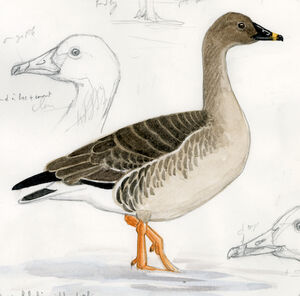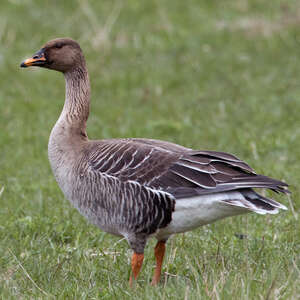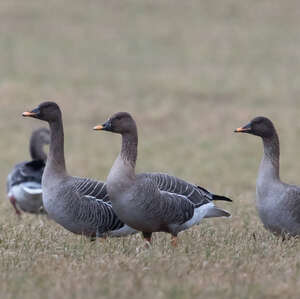Taiga Bean Goose
Anser fabalis - Oie des moissons
Identification
The taxon Taiga Bean Goose has evolved a lot. Initially, it grouped together in subspecies all the morphs presenting roughly the same characters: a black and orange (or pink for one of them) bill and orange legs. After some events, the current situation is the following: the taxon gave birth to 3 species, the Taiga Bean Goose itself, the Tundra Bean Goose and the Short-billed Bean Goose. We are treating here the first one, Anser fabalis.
The Taiga Bean Goose is a grey goose, according to the current terminology, meaning it has a brown to grey-brown plumage on top. To identify a gray goose, one must pay attention to the silhouette and especially the head characteristics. There is no sexual dimorphism.
The Taiga Bean Goose has 3 sub-species which size increases from West to East. A. fabalis fabalis, the Western ssp, is the smallest one and the one with the shortest bill. For this reason, it is likely to be confused with the Tundra Bean Goose on the European wintering sites. It has a medium-length neck and bill, but this is quite subjective and implies prior knowledge of the birds in the field. The bill should be paid attention to. It is moderately high at the base and usually has a slightly concave culmen which makes it seem quite long. It is bicolor, black and orange, the orange color covering 1/3 to 1/2 of the surface. Rarely, the orange is reduced to a subterminal ring like in the Tundra Bean Goose. Then, the bill shape is what decides. The eye is dark and the legs are bright orange.
The juvenile looks like the adult but the bill is entirely blackish and the legs are dull yellow.
The Eastern ssp middendorffii is big with a long neck and a characteristic long bill.
Subspecific information 3 subspecies
- Anser fabalis fabalis (Scandinavia to nc Siberia)
- Anser fabalis johanseni (w Siberia)
- Anser fabalis middendorffii (e Siberia)
Foreign names
- Oie des moissons,
- Ánsar campestre,
- ganso-campestre,
- Waldsaatgans,
- vetési lúd,
- Taigarietgans,
- Oca granaiola della taiga,
- tajgasädgås,
- taigasædgås,
- hus siatinná,
- husa polní,
- Sædgås,
- metsähanhi,
- oca de bec curt,
- Akurgæs,
- gęś zbożowa,
- sējas zoss,
- njivska gos,
- Гуменник (лесной гуменник),
- ヒシクイ,
- 豆雁,
- 寒林豆雁,
Voice song and call
Habitat
The Taiga Bean Goose breeds along the lakes and rivers of the taiga, usually in mineral-rich marshes and peat bogs in the midst of conifers. It winters to the south of the continent, from Western Europe to Japan, in large wetland areas or better on agricultural lands, particularly in unploughed crops offering seeds, young shoots, roots and tubers.
Behaviour character trait
Like other Grey Geese, the Taiga Bean Goose is a migratory species. In wintering, it splits into two distinct groups: the western group flies towards Europe, whereas the eastern group heads towards North China, the Korean peninsula and Japan.
The dividing line of the migratory routes lies around the estuary of the Ob river. In Europe, the group wintering in Central Europe is much bigger than the one wintering on the coasts of the North Sea. A stay in Hungary or Romania in January or February is a good option to see many Grey Geese.Flight
In a perfect row, with its neck extended forward, keeping the same distance from each other and slightly offset from the bird in the front, they soar through the sky. Their flight patterns form an identifiable V-shape, with the leading bird exerting the most effort as they switch off regularly. This is the classic look of the Taiga Bean Goose in flight.
Dietfeeding habits
The Taiga Bean Goose is an exclusive vegetarian. During the summer, its diet is mainly composed of green plants, particularly grasses and sedges. In the summer, it supplements its diet with berries. During the winter, it grazes in meadows or forages crop residue, seeds, roots, rhizomes or tubers. It is likely its taste for cereal grains that won it its French name.
Reproduction nesting
The nest is a pile of vegetation lined with downy feathers. It is built near water, hidden by the vegetation of the marshland or bog. The female lays 4 to 6 eggs in it, and she alone looks after them for 27 to 29 days. Several nests can be quite close to each other without forming a colony.
Geographic range
The Taiga Bean Goose occupies the northern taiga habitat from eastern Scandinavia to the Far East region of Russia. In winter, its range moves southward, spanning from western and central Europe to South and East Asia, Iran and Turkmenistan to Eastern China. It is also widely present in the Korean Peninsula and Japan.
Threats - protection
IUCN conservation status
concern
in the Wild
threatened
evaluated
Currently, the species is not threatened. However, the current global warming could potentially change the situation in the future. Already now, fewer birds are descending into the traditional wintering areas, and those who are going, are arriving later and staying there for a shorter time.
Sources of information
- IOC World Bird List (v15.1), Gill, F and D Donsker (Eds). 2025-12-07.
- Guide des canards, des oies et des cygnes, Steve Madge
- Ducks, Geese and Swans, Kear, J
- Les palmipèdes d'Europe, Géroudet P., MAJ M. Cuisin
- Wildfowl: An identification guide to the ducks geese and swans of the world, Madge, S and Burn, H
- Birds of the World, The Cornell Lab of Ornithology
- xeno-canto, Sharing bird sounds from around the world,
Other sources of interest
 Specification sheet created on
25/07/2023 by Jean François
Specification sheet created on
25/07/2023 by Jean FrançoisTranslation by AI Oiseaux.net
© 1996-2026 Oiseaux.net
- Accipitriformes
- Aegotheliformes
- Anseriformes
- Apodiformes
- Apterygiformes
- Bucerotiformes
- Caprimulgiformes
- Cariamiformes
- Casuariiformes
- Charadriiformes
- Ciconiiformes
- Coliiformes
- Columbiformes
- Coraciiformes
- Cuculiformes
- Eurypygiformes
- Falconiformes
- Galliformes
- Gaviiformes
- Gruiformes
- Leptosomiformes
- Mesitornithiformes
- Musophagiformes
- Nyctibiiformes
- Opisthocomiformes
- Otidiformes
- Passeriformes
- Pelecaniformes
- Phaethontiformes
- Phoenicopteriformes
- Piciformes
- Podargiformes
- Podicipediformes
- Procellariiformes
- Psittaciformes
- Pterocliformes
- Rheiformes
- Sphenisciformes
- Steatornithiformes
- Strigiformes
- Struthioniformes
- Suliformes
- Tinamiformes
- Trogoniformes






























